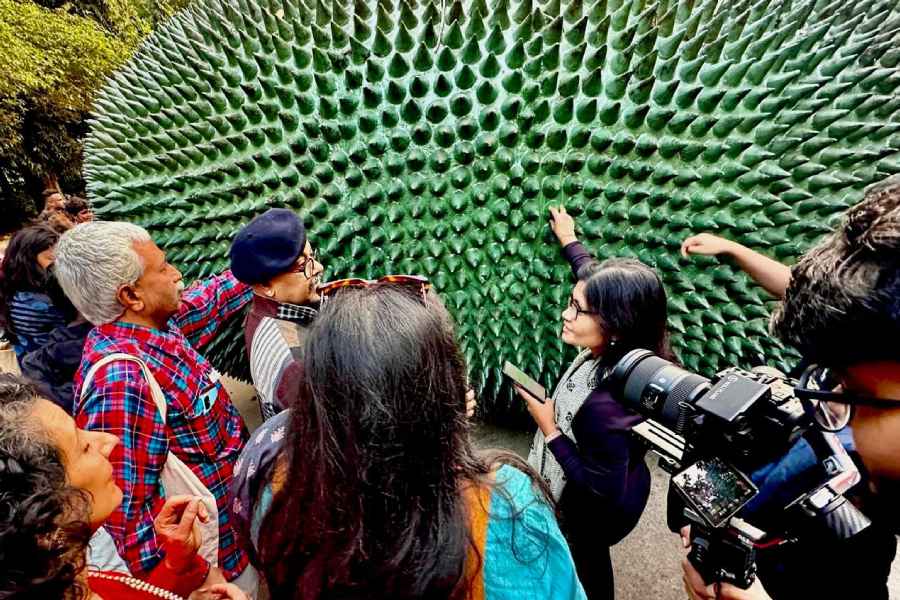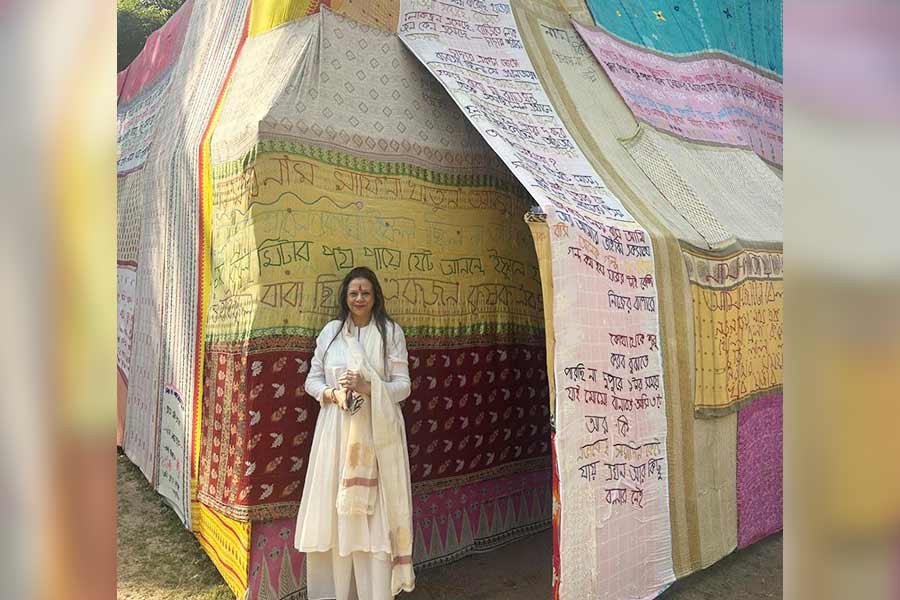There is an elegiac strain in the show Dayanita Singh has brought to the Indian Museum for the Bengal Biennale. She pays tribute to the maestros of Indian Classical Music with an exhibition dedicated to them as they travel across the country in the ITC SRA caravan, performing in minor towns and smaller cities. There is a group gathered around one particular pillar that has a garland of tuberoses strung around it, on closer inspection, we realise that it has been created with images of Rashid Khan, who passed away recently, that is why music-loving people are standing by, to get a closer look. The Museum of Tanpura also has photographs of other legendary musicians as they relax and enjoy each other’s company, including Pandit Shiv Kumar Sharma, V G Jog, Pandit Hari Prasad Chaurasia, and Zakir Hussain. It is Zakir saab’s animated face caught in many different moods that we all remember immediately when the tragic news of his passing reached us, so vivid were Dayanita Singh’s images that had brought alive the legend of Zakir Hussain. In more ways than one, the exhibition in that cavernous space at the city’s museum would also indelibly become a tribute to Zakir.
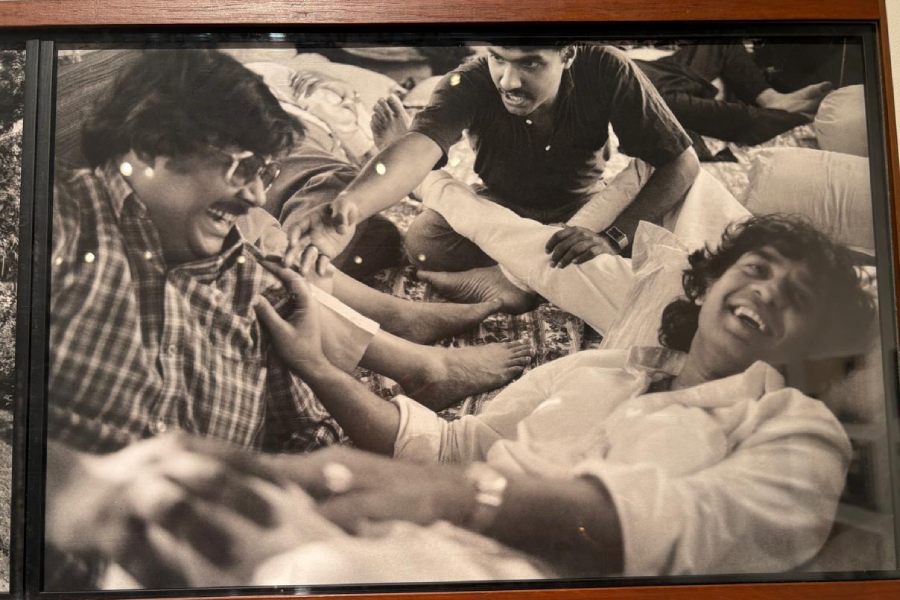
The Museum of Tanpura has photographs of legendary musicians as they relax and enjoy each other’s company
Wandering across the city over the next few days and taking in the scale and scope of the Bengal Biennale, I was reminded of the words of the visionary Okwui Enwezor, who had said on the occasion of the 2019 Venice Biennale that he had co-curated: ‘I am also trying to frame the work against some sense of a real base rather than an adopted base, a primal emotional base rather than a constructed space.’ That was perhaps why the Bengal Biennale had worked for the viewers so remarkably because the works unfolded as a part of a continuum bridging different eras and histories, spanning across memories of individuals and communities.
The Alipore (Jail) Museum was a venue that was used effectively to showcase some brilliant exhibitions, beginning with Kali: Reverence & Rebellion (DAG, curated by Gayatri Sinha). Drawing upon mythology, abstraction, and her veneration as a symbol of rebellion in the nationalist era, the superbly researched show is a tribute to the icon’s continuing allure as a subject for artists even in contemporary times. In another section, Aradhana Seth’s Sadak: Jaile Baire, the photographic fragments act as forces guiding one through the landscape of memory, where stories we leave behind influence and impact our future actions. Bappaditya Biswas’s Liberation, located on the site imposing mandatory labour under colonial rule, is the perfect venue for his indigo textile works that revisit the ideas of liberation, resistance and reinvention that continue to remain relevant down the decades.
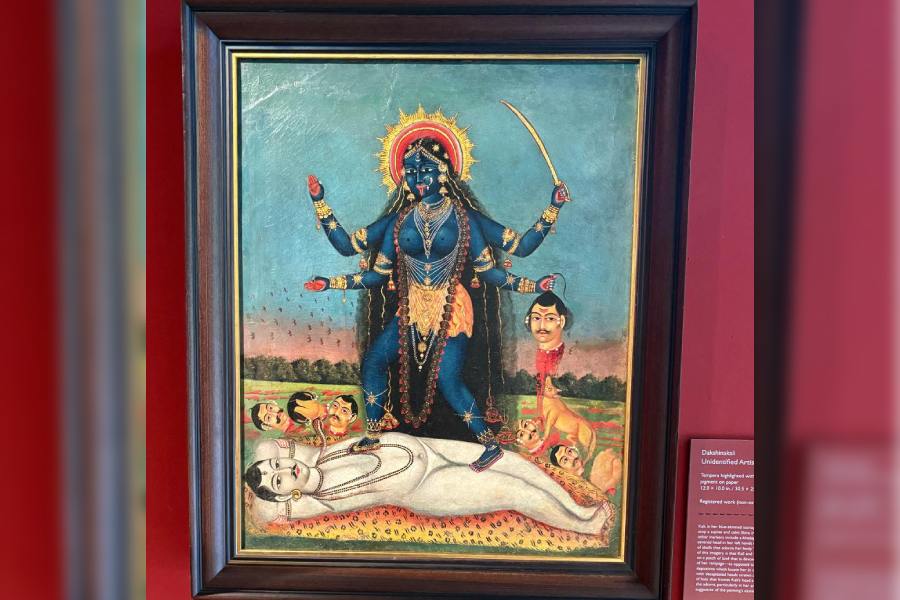
A part of the ‘Kali: Reverence & Rebellion’ exhibition
In my dialogue with Bappaditya at the Alipore Museum, we explore the significance of the indigo textiles that symbolise ‘liberation’, reiterating that freedom is an ever-evolving process that is made possible by the participation of collective hands and shared stories. Somewhere, the exhibitions reflect upon the leitmotif that history becomes clearer when viewed through the lens of reflection. Arpan Mukherjee’s evocative project using glass plates to evoke the almost-spectral presence of the past also harks back to lingering memories. Cell No 5 is the site for Sheela Gowda’s intensely powerful work Interrogation Room where the jail frames the installations within the context of its history of incarceration and resistance. What was freedom won for? The question hangs in the air, unanswered.
The presence of a massive jackfruit adds to the festive banners advertising the Bengal Biennale at Kolkata’s most famous landmark, the Victoria Memorial, where tourists are posing with the metal sculpture before making their way into the compounds. Paresh Maity, a renowned artist hailing from Bengal, focusses on the urbanscape that packs in human habitation within cramped structures. Maity critiques the unfulfilled promises of the metropolis transforming the gigantic fruit, familiar to Bengalis as ‘kathaal’, into an object of fascination as much as disillusionment. The subjects of his artistic observation, meanwhile, were celebrating ‘high art’ by taking selfies, which, again, was the theme across the road at the Academy of Fine Arts.
The purpose of a biennale
Within the hallowed salons at Victoria Memorial, we were part of the collective euphoria of the viewers admiring the works of Abanindranath Tagore, Gaganendranath Tagore and Sunayini Devi curated by R Sivakumar. The Tagore siblings belonging to the famed Jorasanko family won laurels individually for their brilliant contributions to Indian art, in fact, Sunayini Devi is regarded as the first woman painter of the modern period, while the older brothers also became pioneers in their own ways. To view the exquisite paintings rarely seen before in this exhibition ‘Between Home & the World’, amidst a bustling crowd of tourists who are on a sightseeing visit to the city and perhaps be viewing art for the first time was especially meaningful, because shouldn’t that be the purpose of a biennale to bring the public within the space of high art. This was for me the primary reason why the Bengal Biennale was successful, the fact that they chose public spaces open to anyone who cared to visit.
Across the hallway, Dibakar Karmakar, the head of security, and in his heart a passionate art conservator, escorted us to the section exhibiting the exquisite works of Henri Cartier-Bresson. Titled ‘In the Presence of the Eternal’, these photographs showed a rare footage of Sri Aurobindo and The Mother, a priceless testament to his craft and the legacy of the Pondicherry ashram.
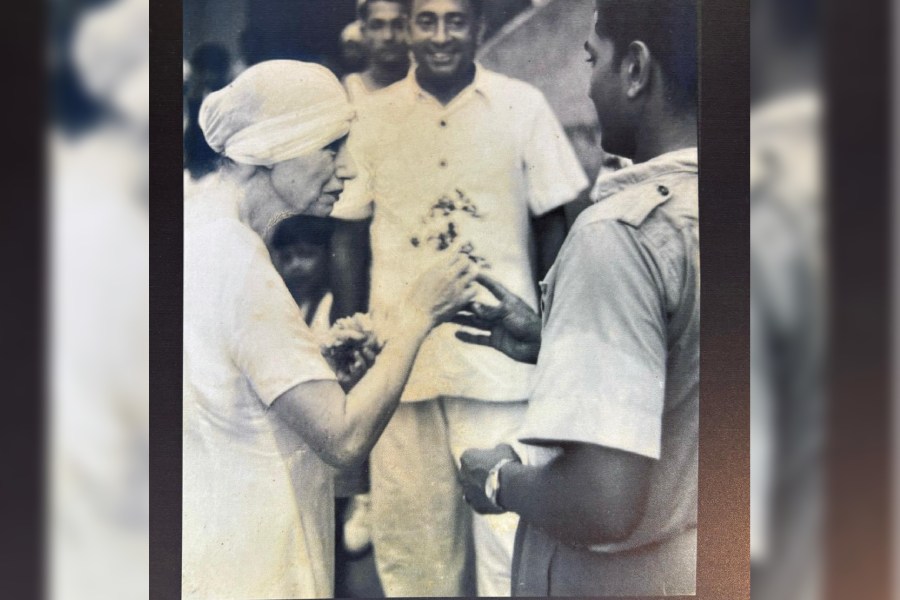
Titled ‘In the Presence of the Eternal’, Henri Cartier-Bresson’s photographs showed rare footage of Sri Aurobindo and The Mother
A very different set of exhibitions awaited us at across the road at the Academy of Fine Arts, now newly refurbished, with its own displays on the first floor. The first titled ‘Selfie: The Artist in Third Person’, curated by Malavika Banerjee, was an interesting take on the concept of self-portraits focusing on the works of MF Husain, Manu Parekh, Jyoti Bhatt, Bhupen Khakar and Jayasri Burman, among others. In modern times, a smartphone is equally adept in presenting the self in a filtered avatar. Is this seemingly lighthearted act much different from mastery and skillful self-portraits painted by the artists? Typically throwing up queries rather than answers, Sudarshan Shetty’s ‘One Life Many’ is a provocative interplay between reality and illusion, sculptural and video installation drawing the viewer into a moment where boundaries blur and definitions are everchanging. Sometimes, you are tempted to slow your pace and absorb in silence, and that was how it was in the darkened room, standing before Shetty’s film.
In the next room, Paula Sengupta and Sujoy Das, impressed yet again with ‘Into Exile - The Tibetan Predicament’ their elaborate story of exile and survival. The braiding of the visuals and dialogue between Sengupta’s deeply intricate installations alongside Das’s photographs revisits issues of belonging and loss as we are invited to witness the Tibetan struggle and how they are trying to cope with the predicament of their severely imperiled culture.
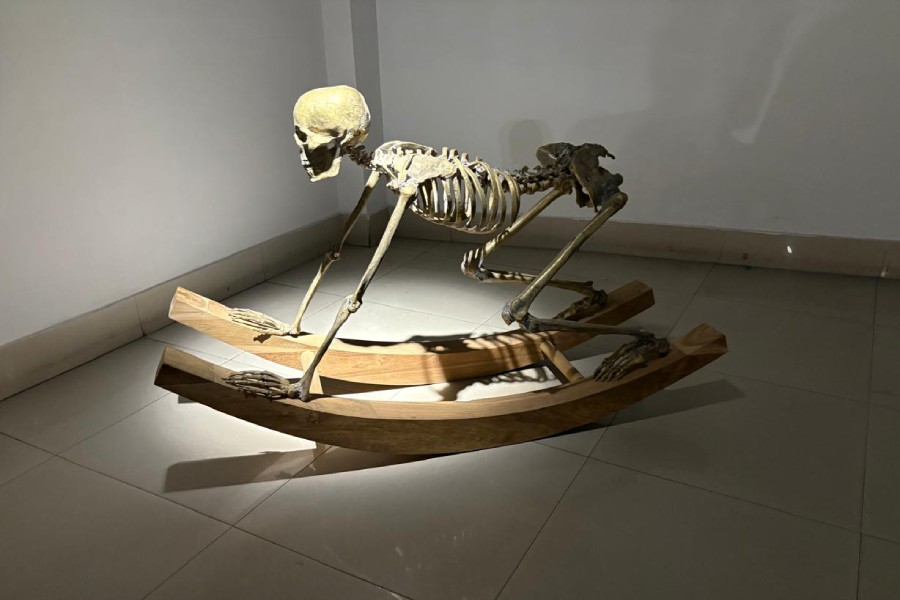
Sudarshan Shetty’s ‘One Life Many’ is a provocative interplay between reality and illusion, sculptural and video installation
Dealing with the scars of Partition, Chhatrapati Dutta’s visceral work asks how do we reconcile with a history that refuses to remain in our past, disrupts our present and defines what we may make of ourselves in the future. ‘Shadow Lines’ focuses on the deep divide that impacted lives in 1905 and 1947. The powerful work confronts the residual violence that still simmers somewhere within and threatens to implode any moment.
Next door at Gaganendra Shilpa Pradarshansala there is the buzz of the ongoing film festival that is also happening in Kolkata, but within the premises is ‘The World of Jamini Roy’. As the curator’s note says: ‘While not a modernist in the conventional sense, his works embody a distinctly modern ethos-anchored not in the aesthetics of abstraction or experimentation but in the ethics of cultural reclamation.’ No celebration of the city’s art & aesthetics would ever be complete without acknowledging the immense contribution of Jamini Roy, the one person who popularised ‘Bengal’ art across the country & the world.
Struck anew by the purity and spirituality of the work
Though not from Bengal but a person who spent years of her life in Calcutta when her husband, the renowned painter Manu Parekh, worked at the Weaver’s Centre, 1965-1974, Madhvi Parekh’s inclusion in the Bengal Biennale 2024 seems most fitting. It’s nearly dusk and St James Church (newly painted for the Christmas celebrations) is illuminated with the setting sun when we enter. The long hall is the venue where her works on Christ are displayed, the long stained glass windows catching the last rays of the sun and throwing shadows on the floor. Inexplicably, I find myself murmuring a silent prayer as I sit for a while on the bench placed before The Last Supper. Even though I have had the privilege of witnessing some of her works being painted in her studio, I am struck anew by the purity and spirituality of the work. The memory of the exhibition and the experience of sitting alone by myself before the painting will be hard to forget.
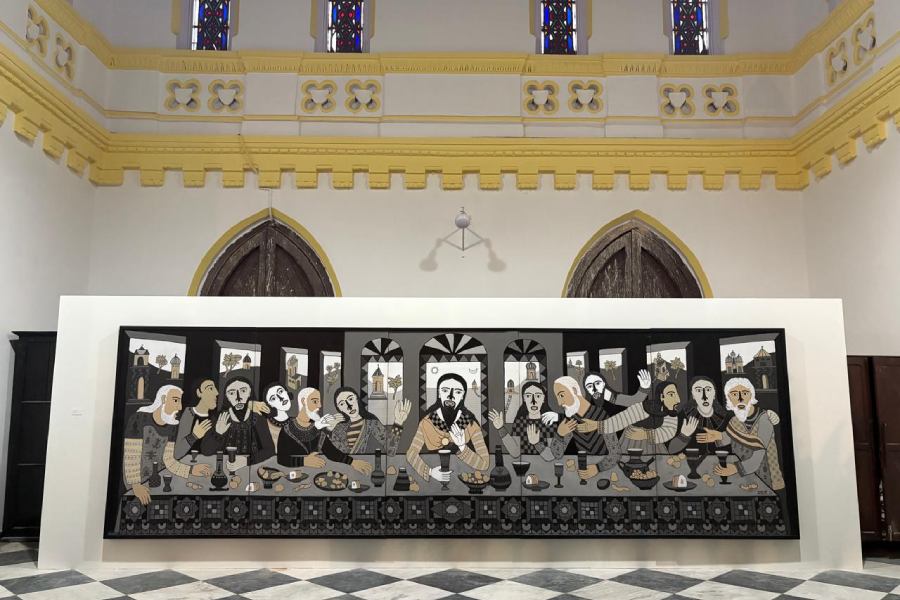
Madhvi Parekh’s work displayed at St James Church
The Red Bari impressed in a very different way, with the works of three contemporary artists showing in the beautiful old house on Sadananda Road, Samindranath Mazumdar, Adip Dutta and Nilanjan Bandopadhyay. Samindranath explores the tension between creation and destruction through pyrography on paper with a luminous effect. Dutta’s ‘Archeology of the Present’ evokes not just material history but the history of our seeing and being through a vision shaped by fragments & remains of the building. In other venues, ‘A Symphony Interrupted’ left an indelible impression on me, an exhibition of TK Padmini’s curated by R Sivakumar. The exhibition I had curated, ‘The Tradition of Bat-tala & Other Practices by Printmakers’ was a concurrent show to the Biennale and it amazed us to see the huge numbers streaming in every day at Birla Academy even though the city was abuzz with so many major art shows.
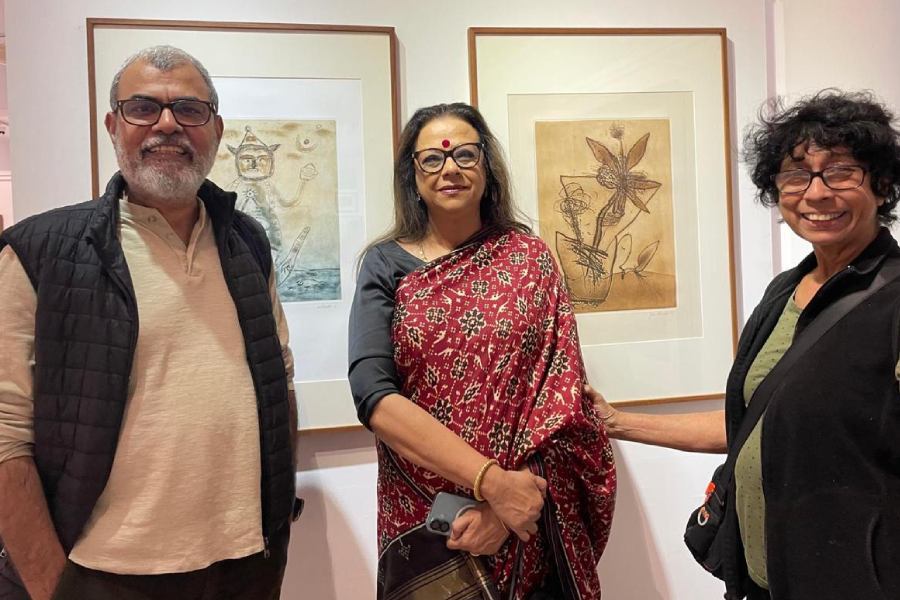
The exhibition the author, Ina Puri (centre), curated, ‘The Tradition of Bat-tala & Other Practices by Printmakers’, was a concurrent show to the Biennale
While each show was a worthwhile addition to the Biennale, I was particularly impressed with the exhibitions at Arts Acre. Jayashree Chakravarty’s ‘Anka-Banka Jomi’ was a spectacular extension of her art practice and the space gave her the scale she required. Chandra Bhattacharjee’s ‘Primaeval’ spoke of a menacing silence that was passive but pregnant with tension as if waiting to explode, the colours on his canvas, dark and sombre. The immense space also had two exhibitions by the veteran artists Shanu Lahiri and Shuvaprasanna which were wonderfully curated. Being familiar with Lahiri’s work from my girlhood, I was especially pleased to see her get her rightful place at the Biennale.
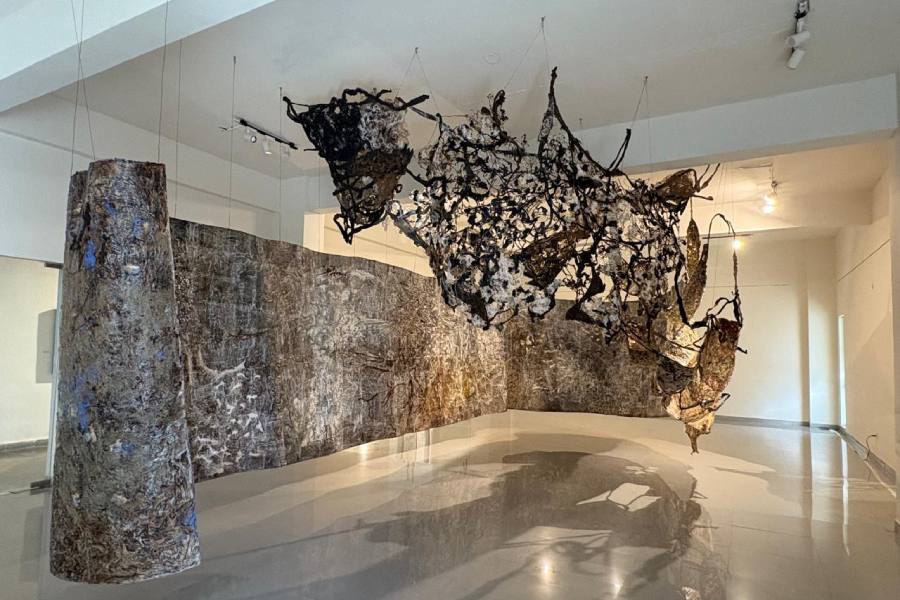
Jayashree Chakravarty’s ‘Anka-Banka Jomi’ was a spectacular extension of her art practice and the space gave her the scale she required
Finally, I conclude with the magnificent project by Pradip Das titled ‘Hridaypur’, where place and memory dissolve into one another, making Naktala more than just a location. Das’s work seeks to draw the audience within the complex structure he has created using voices, narrations, old trunks and bed posts familiar to us from another time. The effect he achieves is spellbinding. As I prepare to leave the city, the Biennale is still drawing packed houses everywhere and we hear of performances and panel discussions in the pipelines before the closing hour.
As the curator of his first biennale, Sivakumar has done a commendable job and it truly is ‘an encounter between past and present, the local and global, not a simple juxtaposition but an intricate dialogue – a living breathing exchange where each element reshapes and reinvigorates the other within the discursive framework.’ Till Edition Two, then, Siddharth Sivakumar and Jeet and Malavika Banerjee.
